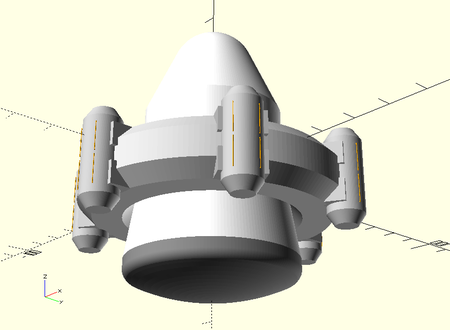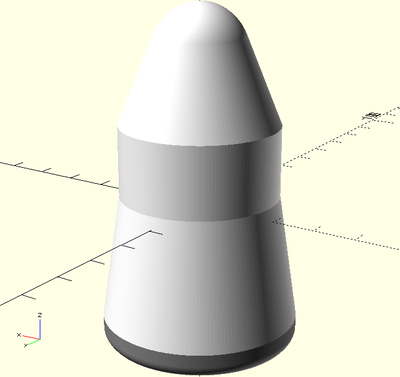Difference between revisions of "USS Poul Anderson"
(→Krechet: add Cyrillic) |
(→Krechet: add Cyrillic) |
(No difference)
| |
Latest revision as of 06:07, 24 January 2017
USS Poul Anderson
Background
The United States Starship Poul Anderson is one of the landing vehicles of the first Alpha Centauri expedition, as described in Alpha Centauri: First Landing and Alpha Centauri: Sawyer's World. It is named (both in the book and in real life) for renowned American science fiction author Poul Anderson (1926-2001), winner of, among other awards, seven Hugos and three Nebulas.
Alastair Mayer, the creator of T-Space, is a fan of Anderson's work and met and worked with him at several meetings of the Citizens' Advisory Council on National Space Policy.
The book Alpha Centauri: First Landing is dedicated to both Poul Anderson and Robert A. Heinlein (after whom the expedition flagship is named).
Details
Like the other landers in the book, the USS Poul Anderson is based on a SSTO ship (similar to the Phoenix series designed by Gary Hudson at Pacific American Launch Systems) for the planetary descent and ascent phases, which docks with an Interstellar Propulsion Module or "warp collar" which provides warp capability. The vehicle has a nominal crew of five but can carry ten if required (depending on planetary gravity, launch latitude, etc.) The design is approximately a blunt cone with circumferential rocket nozzles around the heat shield to create an aerospike.
The following CAD images show an Anderson-type lander with and without its warp collar. (Details like windows, hatches, RCS engines, landing gear, etc are also omitted.)
Other ships in class
In the book, the landers are all derived from a commercial SSTO design. Detailed differences would include the hardpoints and latch mechanisms for docking with the warp collar, additional control systems for same, reinforced landing gear, longer-duration life support systems, and the interior fitted out with appropriate labs rather than simpler cargo areas and/or passenger seating. For purposes of this wiki, we'll refer to this as the "Anderson class" ships, although the term in not used in First Landing.
The international ships based on this class are each built by their respective nations, starting with the standard hull design and specifications. Subsystems and components are standardized as far as possible, and off-the-shelf from various manufacturers around the globe as expedient.
Subrahmanyan Chandrasekhar
This Indian lander is named for the 1983 Nobel-prize-winning astrophysicist perhaps best known for the "Chandrasekhar Limit", the maximum mass for a stable white dwarf star (beyond this, such stars either explode or collapse to neutron stars or black holes). Although Chandrasekhar was born in Lahore which is now (2016) in Pakistan, it was part of British India at the time. Chandrasekhar calculated his limit at the age of 19 while living in India, he later emigrated to the United States. He made a number of other important contributions to astrophysics, quantum theory, and the theory of black holes and gravity waves.
In the book The Chara Talisman, the ship which takes Dr. Hannibal Carson to Verdigris is an S-class starship also named Subrahmanyan Chandrasekhar, in honor of both the astrophysicist and the above lander. It is owned by Drake University on Sawyers World, piloted (at least in Chara) by Rajesh Gupta.
Krechet
The Russian lander, Krechet (Кречет), is named after the Russian word for the bird gyrfalcon. The Krechet was also the designation for a lunar excursion space suit designed for the (later defunct) Soviet moon program. (As Krechyet, this was also the project name for the Kiev-class of Soviet aircraft carriers.) The bird gyrfalcon is the largest of the falcons, whose breeding grounds comprise Arctic coastal areas.
Jules Verne
This was to have been the European lander, named after the famous French science fiction and adventure author. Due to (unspecified) technical issues encountered on its shakedown testing flights, it had to undergo extensive repairs and was not ready in time to accompany the rest of the first expedition fleet. Crew assignments were shuffled to allow some of the European crew to participate in the voyage on other ships.

